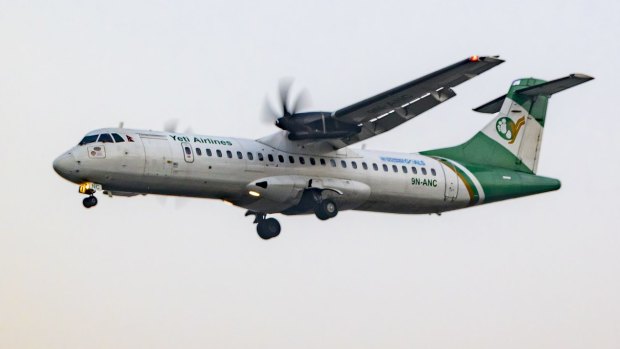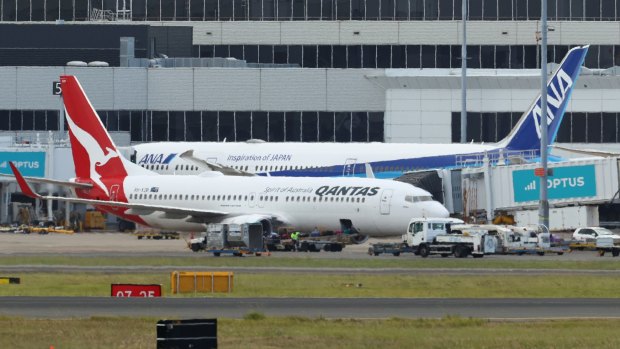This was published 1 year ago
European Union Air Safety List: The airline 'blacklist' that reveals risky carriers
By Katherine Scott

A Yeti Airlines plane crashed on Sunday, killing 72 people. The airline is one of many banned from flying to the EU.Credit: Getty Images
Sunday's Yeti Airlines crash in Nepal is the latest deadly aviation accident to beset the small nation, killing all 72 people onboard, including one Australian passenger.
An investigation is still underway as to what caused the 15-year-old ATR 72-500 aircraft to crash suddenly, shortly before it was due to land in Pokhara.
Three days later, reports circulated that a Qantas Auckland-Sydney flight had issued a mayday call following mid-air engine trouble. The raised alarm saw flight QF144's twin-engine Boeing 737-838 become the most-tracked flight in the world on flightradar24.com, with 133,000 people tuning in for its landing.

Qantas flight QF144 at Sydney Airport on Wednesday. The flight landed safely after a mayday call due to an engine failure mid-flight from Auckland.Credit: Getty Images
At one point, the engine issue had been downgraded to a PAN (possible assistance needed), and the aircraft touched down at Sydney Airport without incident, albeit with visible damage to one of its engines. As a precaution, Sydney Airport had emergency crews on stand-by.
While a full picture in both cases is yet to emerge amid investigations, the very different outcomes for the two carriers – one, currently banned from operating in Europe due to safety concerns, and another, a world leader in air safety – reinforce the importance of airline red-flag lists.
These lists can be used by anxious flyers to easily identify carriers with poor safety records before they spend big money on overseas flights.
While commercial aircraft accidents are extremely rare today – in fact, it's one of the safest forms of travel – some airlines and countries have worse records than others.
Qantas, recently voted the world's safest airline for 2022 by AirlineRatings.com, has never had a fatal jet airline accident.
Conversely, the Nepali carrier at the centre of the Pokhara tragedy, Yeti Airlines, is one of 20 Nepal-based airlines on the European Union Air Safety List (ASL) – an internationally-recognised and frequently-updated list of air carriers from non-EU nations banned from operating to, in and from the EU due to not meeting necessary international safety standards.
The list can be used as a reference guide for flyers, according to Chrystal Zhang, an aerospace engineering and aviation expert at RMIT University.
"It's definitely one of the very reliable resources for anyone who wants to check the [carrier's] safety performance and capability of the government [to manage] safety performance," said Zhang. "It is one of the purposes they developed that list."
The banned or partially banned airlines are determined based on information gathered by aviation safety experts from all the EU Member States and the Commission. This includes assessment of both the individual airline and its associated governing authorities.
"They would determine whether the carriers have valid, appropriate safety management systems in place to satisfy the EU's requirements… Then they would check the capability of the government agency – in [the Yeti Airlines] case the Civil Aviation Authority of Nepal – to establish to what extent they're capable of overseeing the overall management system of their aviation sector." said Zhang.
The decision to include all 20 Nepali carriers on the ASL is a sign the EU has identified a lack of safety oversight by the local aviation authorities of Nepal.
Professor Rico Merkert, an aviation expert at the University of Sydney, said: "It is important to note that this assessment is made against international safety standards and notably the standards promulgated by the International Civil Aviation Organisation (ICAO) – not the EU safety standards, which are sometimes more stringent."
It's no coincidence developing countries feature disproportionately in the blacklist; there's less overall capability to invest in facilities, infrastructure, pilots, training, and develop and implement safety management systems and regulation policies.
"Perhaps the more economically developed – the more advanced – the safer your country is," noted Zhang.
As of November 2022, 118 air carriers are banned from EU skies, with most of the blacklisted airlines hailing from developing countries in Africa and parts of Asia.
Can carriers on the list redeem themselves? In short, yes. In the 41 iterations of the EU blacklist, a number of carriers have later been removed, typically following significant improvements to its governing aviation body's safety regulations.
In 2009, nearly two years after a Garuda Indonesia flight overshot the runway in Yogyakarta airport, exploding and killing 21 (among them five Australians), the European Commission announced four Indonesian airlines – Garuda, Airfast, Mandala Airlines and Prime Air – had been removed from the list. The decision followed an overhaul to the nation's safety standards. In 2016, Lion Air fell off the list, and in June of 2018, the European Commission cleared all remaining Indonesian air carriers.
While Australia doesn't have an equivalent ban list in place, the Australian Civil Aviation Safety Authority (CASA) regulates who gets an Air Operator's Certificate (AOC) to operate safely in Australia.
"This means any Australian airline will be safe," said Merkert. "Foreign carriers are not permitted to fly into Australian airspace until they receive a Foreign Aircraft Air Operator's Certificate (CASA). As such, I feel in safe hands."
While the EU Air Safety List can be a first port of call for travellers looking to make a safe airline choice, another useful and consumer-friendly tool for flyers to consider is the Airline Ratings. The website rates carriers based on a blend of criteria including appearance on the EU blacklist, fatal incidents in the past five years, and performance in major aviation audits including IOSA, ICAO and EU and FAA.
Sign up for the Traveller newsletter
The latest travel news, tips and inspiration delivered to your inbox. Sign up now.